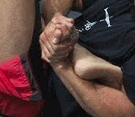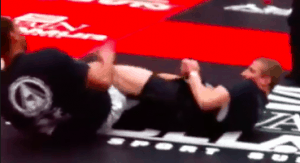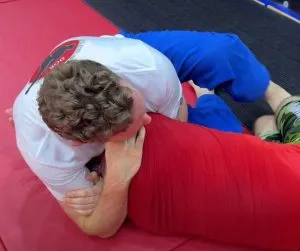Heel hooks have become one of the prominent submissions in all of Jiu Jitsu. But it wasn’t always this way.
For decades, heel hooks were banned from tournaments. They had a stigma for being too dangerous to use, but in modern Jiu Jitsu things are changing.
Today, heel hooks are practiced now more than ever and are now being allowed in more competitions. So, with heel hooks coming into the mainstream of Jiu Jitsu, you must know how to use and defend them.

This is one of the most complete heel hook guides you will find on the internet today. We’re going to give you everything from the history of heel hooks and how they work. Then we’ll detail numerous heel hook entries from different positions for you to go practice.
The History of The Heel Hook
The heel hook was developed thousands of years ago within ancient forms of grappling. Ancient wrestlers from Egypt, Greece, and Roman have all been documented using leg locks including the heel hook.
Everything from drawings, sculptures, and even martial art books depict and describe heel hooks being used. One of the earliest grappling forms that we know used heel hooks was the Greek based martial art of Pankration.
These techniques would be passed down for generations and adopted by numerous grappling arts. Jiu Jitsu would adopt heel hooks from Judo, but Master Carlson Gracie disagreed.
He claimed a Brazilian Vale Tudo wrestler he trained with named Ivan Gomes invented them. Although Gomes’ younger brother José said these claims were untrue.

From an interview BJJheroes did with José, Gomes claimed that he and his brother’s coach Zé Maria taught them. Then before that, their coach’s Judo coach from Japan, Takeo Yano. Another Japanese Judoka that migrated to Brazil and had a hand in establishing BJJ.
Heel hooks sort of fell into the shadows during the 1970s, when sport Jiu Jitsu started to take shape. Those submissions along with spinal locks and kneebars were banned from official competitions.
Since they couldn’t be used in competitions, many Brazilians stopped using them. These leg locks wouldn’t make a comeback until the late 90s, when the ADCC Championship was established. In those submission wrestling tournaments, all submissions were allowed including heel hooks.
With the creation of these types of events, heel hooks started to make a comeback. Then when the 2010s came around, their popularity exploded.
This was thanks in part to the emergence of more submission grappling tournaments and shows like the ADCC. Promotions like the Eddie Bravo Invitational, Polaris, and for a short time Metamoris allowed heel hooks in their competitions.
This led to an emergence of many BJJ stars that specialize in leg locks. They would come from BJJ teams like the Danaher Death Squad, Dean Lister, 10th Planet, and Absolute MMA began focusing on them.
Today heel hooks have come into the mainstream and changed the landscape of BJJ.
It must be noted that the heel hook can be seen in many other grappling arts such as catch wrestling, shooto, pankration and luta livre but the heel hook submission has really gained fame through Brazilian jiu-jitsu as the total amount of practitioners in BJJ dwarfs any other grappling art thus better help promote, evolve and develop the heel hook submission to be even more effective than that of the past.
How do Heel Hooks Work?
Many would assume with a name like heel hook that the submission would attack the heel of your opponent. What the submission actually targets is the knee of your opponent.

Before going into the submission, you set it up by establishing control over your opponent’s hip, knee, and foot. Once you’ve established control over those three points, you then bend their knee to around a 90 degree angle.
Putting your opponent’s knee at this angle creates tension on their joint. Then by turning into their leg and hook their heel this puts immense pressure on your opponent’s knee ligaments.
If your opponent does not tap or isn’t quick to tap, this will lead to immense damage to their knee. So be careful when you put this submission on.
Types of Heel Hooks
There are two types of heel hooks that are used in BJJ and submission grappling. The outside heel hook and the inside heel hook.
- Outside heel hook: The outside heel hook is the more traditional of the two types of heel hooks. Your opponent’s leg is placed on your outside hip and you attack the outside part of your opponent’s heel.
- Inside heel hook: An inside heel hook is the reverse of an outside heel hook. You place your opponent’s foot on your inside hip to attack the inside of their heel.
Between these two types of heel hooks, the more dangerous of the two is the inside heel hook. The reason for this is because the inside heel hook targets the anterior cruciate ligament (ACL).

It also comes on faster than the outside heel hook. Although, the outside heel hook can also deal quite a lot of damage when put on.
The Legality of Heel Hooks in BJJ Competitions
For the better part of nearly 50 years, the heel hook has been banned by most BJJ federations. This includes the Confederação Brasileira de Jiu-Jitsu (CBJJ) and its international affiliate, the International Brazilian Jiu Jitsu Federation.(IBJJF)
The only major federation that allowed them was the ADCC when they formed in the mid 1990s. Within their trial events and of course the championship tournament.
If you wanted to use heel hooks in competition, your only real choice for the longest time was a NAGA event.(North American Grappling Association.) Even then, you had to sign up for the expert No-Gi level in order to be allowed to use them.

Although with the influx of BJJ pro shows that allow leg locks, things have begun to change. As of 2021 the IBJJF changed their long standing ban on heel hooks.
They now allow heel hooks for black belts and brown belts in the adult division.(18-29) This will definitely change the landscape of Jiu Jitsu going forward.
Notable Expert Leg Lock Competitors
Here is a list of the most notable expert BJJ athletes that are leg lock experts.
- Gordon Ryan
- Garry Tonon
- Craig Jones

Masakazu Imanari - Lachlan Giles
- Dean Lister
- Masakazu Imanari
- Eddie Cummings
- Rousimar Palhares
- Jon “Thor” Blank
- Nicky Ryan
- Aaron “Tex” Johnson
Leg Lock Positions
It’s not just enough that you know how to lock on a heel hook. You also must have knowledge of the different leg lock positions to get one. Here is a list of some of the most practiced leg lock positions.
- Ashi Garami
- 50/50
- 411
- Inside Ashi Garami
- Outside Ashi Garami
- 80/20
- Knee out position
- Grounded Kani Basami
- Cross Ashi
- Side Saddle
The Heel Hook Techniques
Now that you know a little about the history of heel hooks and how they work, here are various entries. Read each carefully, so you don’t miss any of the details.
Outside heel hook from Ashi Garami
The outside heel hook from the normal Ashi Garami position is one of the first you need to learn. Before you go for the heel hook, you need to establish control over your opponent’s leg.
Your inside knee closes on top of your opponent’s hip and your outside foot attaches above your knee. The foot of your inside leg also needs to hook under your opponent’s far leg.
This connection creates a triangle above your opponent’s knee and you’re basically stuck to them. Now with your opponent’s legs under control, you can now fish out their heel.
Place your outside foot on the mat as you hold behind their knee and turn in to expose their heel. You can now go into your heel hook grip.
Trap your opponent’s toes under your arm as you hook their heel using the blade of your wrist. Then connect your hands together and keep your elbows tight.
Then to finish the move, keep your grip and turn their heel to the inside using your whole body.
Inside heel hook from 50/50
Footlocks like the inside heel hook are really easy to get from the 50/50 position. But while it is really easy it can be dangerous if you’re not careful and easy to defend.
Remember that 50/50 entails that your opponent also has your leg and can also finish you. Also if your hips are square with your opponent’s, they can easily fight your grips.
When you’re in position, grab your heel hook grip and turn on your inside hip. Your opponent’s heel is facing the floor and you have their knee bent.
Finish your inside heel hook from 50/50 raising your hips up and turning their heel outward.
Inside heel hook from the Saddle position
Another popular position to land an inside heel hook is from the saddle position. This is where your outside leg comes across your opponent’s leg and you triangle your legs above their knee. Along with your triangle, your inside foot hooks under your opponent’s far leg.
Remember like always to establish control above your opponent’s knees before going for your heel hook. Hold the position by chopping down with your top leg and pulling your opponent’s leg in with your inside leg.
Doing these two movements together closes space.
Now to put on your heel hook grip, fall to your outside hip as you pull behind your opponent’s knee. This movement causes their knee to bend and exposes their ankle.
Keep your grip behind your opponent’s knee as you trap their foot with your armpit. From here, hook their heel using the blade of your forearm, clasp your hands together, and turn in.
Heel hook from top half guard
Heel hooks can be set up from more positions than just from a bottom position like a guard. You can set them up from the top and one of the easiest places to land one is in half guard.
Start the position up with good posture and place your free knee across your opponent’s belly. Next, you’re going to grab behind your opponent’s and pull their leg into you as you fall to your back.
When you land, your opponent’s knee is bent and their heel is exposed. Hook their heel and go to finish your outside heel hook.
Even if they roll, it puts you right in position for a kneebar.
411 heel hook entry
This 411 entry into the heel hook starts from on top faking a guard pass. From standing with your opponent sitting, you start the entry by stepping in between your opponent’s legs.
Then you immediately do a back step with your other foot around your opponent’s leg. Your outside knee slides under your opponent’s leg as you scoop their leg with your elbow and fall back.
As you fall, your forearm pushes into your opponent’s leg to bend it and expose their heel. Hook the heel and turn out to get the tap.
Floating Z guard to inside heel hook
Starting from the Z guard is a great way to get in position for a heel hook. In the Z guard, underhook your opponent’s leg as you swim behind their arm and palm their armpit.
Use your underhook and hand to push your opponent away and make them base on the mat with their hands. Next, you need to loop your inside leg around your opponent’s body.
You can do this by keeping your frame on their armpit and turn in to make space to pass your leg. Once your leg passes over, you’re going to shoot your hips to the sky and rotate your hips out.
Then after you rotate your hips, triangle your legs together and keep your opponent’s knee on the mat. From here, your opponent’s knee is bent, so all you have to do now is catch their heel.
Trap their foot with your armpit and hook your wrist around their heel, put your hands together, and finish.
Imanari roll to heel hook
By far one of the craziest entries into a heel hook is the Imanari roll. This absurd move on paper shouldn’t work, but it is extremely surprising and effective.
The move starts with both you and your opponent standing. You step and turn away from your opponent for a split second. This bit of misdirection gives you the space to go into your roll.
You fall to your back as your outside leg goes under your opponent’s legs and hooks behind their far leg. At the same time, your inside leg goes around the leg you’re attacking and also hooks behind their far leg. Right under your other leg that is hooking your opponent’s leg.
The momentum of the roll along with your legs hooking your opponent’s far legs trips them up. They fall to their back and you end up right in position to get an inside heel hook.
Important Key Details for The Heel Hook
The heel hook may be the most powerful joint lock in all of grappling when done correctly. Here are the important key details you must remember when locking them on.
The three points of control: When you go for a heel hook, you must remember the three points of control. Those points of control are the hip, knee, and foot. If you do not control these three parts of your opponent’s leg, you are unlikely to get your submission.
Hip alignment: Your hips must be aligned with your opponent in order to bend their leg and close space. Being unaligned with your opponent’s hips opens up space between you and them. Significantly decreasing your chances of getting your heel hook.
Knee Control: To be successful at any leg lock, you must establish control right above your opponent’s knee. This control above the knee holds their leg in place and allows you to set up your submission. When you don’t have control above their knee, they can easily push their leg free.
Foot Control: Remember to use your tricep and armpit to trap the top of your opponent’s foot. Doing this isolates their heel, allowing you to use your forearm to hook it.
Bend the knee: The opponent’s knee must be bent at an angle in order to land a successful heel hook. Either use your hand or leg to bend their knee to the inside or outside. Depending on your leg positioning and whether you want an inside or outside heel hook.
Turn your body into the heel: To hook your opponent’s heel, you turn your body into your opponent’s foot. You do this, so you can isolate your opponent’s foot and heel before locking in your submission.
The grip: The heel hook grips you can use include the palm on palm, butterfly grip, reverse butterfly grip, and RNC grip. Choose the one that works best for you.
Elbows in: Do not flare your elbows out once you lock your grip. Keep your elbows in, so it makes it more difficult for your opponent to break your grip.
The Finish: After locking in your grip, slowly turn away from your opponent’s heel. Turning on the top of your back as you slightly lift your hips and rotate.
Be Careful!: The heel hook can severely damage the knee of the person you use it on if you’re not careful. When practicing the heel hook, always remember to put it on slow, so you don’t injure your training partner. A knee injury from a heel hook can put someone on the shelf for 6 months or more.
How to Defend The Heel Hook?
To be an expert at heel hooks, you not only need to know how to put them on, but also defend them. Here are the important steps you need to remember for defending a heel hook.
Turn your toes down: When your opponent starts to go for the heel hook, the first thing you must do is extend your toes. Doing this movement makes your heel smaller and harder to grab. More experienced grapplers can still get your heel, but doing this will buy you time to escape.
Keep leg straight: You need to keep your leg stiff in straight whenever your opponent goes for a heel hook. This is because they need to bend your knee in order to get an angle and expose your heel.
Never Fall Back: If your opponent is attacking your legs, the worst thing you can do is fall to your back. Doing this gives your opponent the space they need to control your leg and bend it. You’re basically giving your opponent a heel hook when you fall back.
Free your knee: To break your opponents control, you need to free your knee. When they have control above your knee, they can go to any leg lock they want including a heel hook. Try opening your legs or pushing your opponent’s legs below your knee to get it free.
Hand Fight: Hand fighting is extremely important when you’re trying to defend a heel hook. Your opponent needs to connect both of their hands around your heel in order to get it. If you hand fight with your opponent, this prevents the sub and gives you time to escape.
Foot on the mat: To defend an outside heel hook, try to keep your foot on the mat. Keeping your foot attached to the mat hides your and buys you time to free your knee.
Roll out: Rolling out of a heel hook works for both inside and outside heel hooks. Hold your opponent’s knee, step over their leg, and turn into the heel that’s being attacked. Never roll away from your heel being attacked, because this gives your opponent the heel hook.
Tap: If you are a novice at defending heel hooks, your best option is to tap out and try again. Heel hooks come on instantly and trying to fight out of it will only lead to your knee being severely damaged.
The Heel Hook in MMA
The heel hook is an extremely effective submission with mixed martial arts having been performed successfully since the mid 90’s.

The first real use of heel hooks were within Japanese pancrase and MMA events where it was very common to see fighters go for heel hooks and successfully submit the opponent. The first heel hook in the UFC was performed by Ken Shamrock (a former Pancrase fighter) on Pat Smith with Pat Smith tapping in excruciating pain.
Since that first heel hook there have been many fights ended with this devastating leg submission and to this day the heel hook is a very effective and feared MMA submission as it is quick, dangerous and effective.
In Conclusion
Many different grappling styles teach the heel hook and for a good reason, it simply works. The heel hook has seen a major evolution as of late within BJJ and Submission grappling due to the vast amount of competition the submission has been used in thus forcing new tactics and attacks in order to optimize the heel hooks effectiveness. The heel hook has also shown the effectiveness of BJJ for MMA as it is a true equalizer when placed correctly.
The heel hook is a must know submission and we highly recommend you perfect both attacking and defending the hell hook as once mastered, you truly have a highly effective submission in your arsenal.




